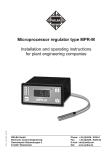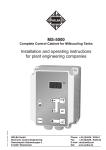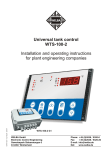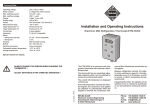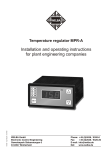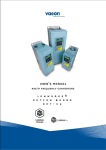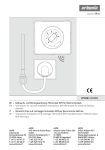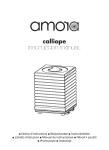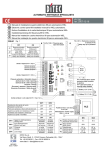Download MRF-M Milk-cooling regulator Installation and operating instructions
Transcript
WELBA Milk-cooling regulator MRF-M 100994 - © by WELBA - 28/08/08 Installation and operating instructions for plant engineering companies WELBA GmbH Electronic Control Engineering Gewerbepark Siebenmorgen 6 D-53547 Breitscheid Phone: Fax: E-mail: Net: +49 (0)2638 / 9320-0 +49 (0)2638 / 9320-20 [email protected] www.welba.de Content Function . . . . . . . . . . . . . . . . . . . . . . . . . . . . . . . . . . . . . . . . . Page 3 Intended use . . . . . . . . . . . . . . . . . . . . . . . . . . . . . . . . . . . . . Page 4 Safety . . . . . . . . . . . . . . . . . . . . . . . . . . . . . . . . . . . . . . . . . . . Page 4 Installation . . . . . . . . . . . . . . . . . . . . . . . . . . . . . . . . . . . . . . . Page 5 Electrical connection . . . . . . . . . . . . . . . . . . . . . . . . . . . . . . . Page 6 Technical data regulator . . . . . . . . . . . . . . . . . . . . . . . . . . . . . Page 7 Sensor dimensions and technical data . . . . . . . . . . . . . . . . . Page 7 Operation . . . . . . . . . . . . . . . . . . . . . . . . . . . . . . . . . . . . . . . . Page 8 Operation overview . . . . . . . . . . . . . . . . . . . . . . . . . . . . . . . . Page 8 Parameter settings in general . . . . . . . . . . . . . . . . . . . . . . . . Page 9 Working level operation . . . . . . . . . . . . . . . . . . . . . . . . . . . . . Page 10 Programming level operation . . . . . . . . . . . . . . . . . . . . . . . . . Page 11 Configuration level operation . . . . . . . . . . . . . . . . . . . . . . . . . Page 12 Intermediate stirring options during cooling . . . . . . . . . . . . . . Page 14 Function permanent stirring . . . . . . . . . . . . . . . . . . . . . . . . . . Page 14 Setting the actual value correction . . . . . . . . . . . . . . . . . . . . . Page 15 Fault indication on the display . . . . . . . . . . . . . . . . . . . . . . . . Page 15 General measures when using electronic control systems . . Page 16 MRF-M 28/08/08 Page 2 Function The MRF-M is a microprocessor-regulated milk-cooling regulator with automatic afterstirring. It has separate relay contacts for the compressor contactor and the stirrer. The measured milk temperature is shown constantly on the display. Two freely adjustable target temperatures may be selected by push buttons. Should the milk temperature exceed the chosen target temperature (T1 or T2) by the hysteresis value, the compressor and stirrer are automatically switched on. Once the target temperature is reached, the compressor contactor switches off. The stirrer continues for the programmed period. During refrigeration pauses, the stirrer automatically switches on again according to the programmed intervals, to ensure an even temperature throughout the milk. Independently of this, short or long "intermediate stirring" can be selected by pressing a button. Software can aIso be used to programme the MRF-M for "permanent stirring", i.e. the agitator is switched on and off by pressing a button. Cooling mode: Press the button cooling: the compressor and agitator operate automatically. In between cooling periods (agitator and compressor LEDs off), intermediate stirring can be activated. lf the start delay is activated (parameter c80 >0), the start of cooling mode is delayed. Pressing the button twice causes cooling to start immediately. Stirring mode lf cooling mode is active (temperature ist shown on display): ! “Short" intermediate stirring: Briefly press the "Agitator” button. "sho" appears in the display, and the agitator starts to operate. ! "Long" intermediate stirring: Press and hold down the "Agitator” button for 5 seconds. "Ion" appears in the display, and the agitator starts to operate. ! Continuous stirring (only if set at parameter level): Press the "Agitator” button. "On" appears in the display. The agitator operates continuously until the "Agitator" button is pressed again. lf OFF mode is active (’OFF’ ist shown on display): ! Continuous stirring while cooling is switched off: Press the "Agitator" button. Actual temperature is shown in the display, and the agitator-LED is flashing. Off mode The regulator can be switched off using the "OFF" button. "OFF" appears in the display. Both the output relays for the agitator and compressor are deactivated. CAUTION: The regulator is live even when switched off. T1 /T2 Switch between target temperatures (when cooling mode is active only). MRF-M 28/08/08 Page 3 Intended use These operating instructions contain important technical and safety information. Please read carefully before installation and before any work on or with the regulator. The microprocessor-controlled regulator type MRF-M is used to control heating and cooling systerns, alarm devices, fans, etc. Any other use of the device is permitted only with prior written permission from the manufacturer. The microprocessor regulator is ready for use once the parameters have been set. lt should not be used beföre this has been done, as this might result in damage to the plant and the item to be cooled or heated. The device is fitted with a resistance temperature sensor. The output ports are designed as potential-free relay ports. The device must not be installed in potentially explosive atmospheres. The microprocessor-controlled regulator type MRF-M fulfils the EC requirements for electromagnetic compatibility (EMC) and the Low Voltage Directive (LVD). The safety components meet the VDE regulations. Safety These operating instructions contain important technical and safety information. Please read them carefully before installation and before working on or with the regulator. The microprocessor regulator must be installed by an authorised specialist, observing local safety regulations. Access to the environment when connected must be restricted to specialised personnel. The microprocessor regulator contains live components and must not be opened up. lt must not be used if the housing or connection terminals are damaged. No fluids must penetrate the housing. The microprocessor regulator may not be exported to the USA without the manufacturer's express permission. MRF-M 28/08/08 Page 4 Installation It is essential not to install the device under the following conditions: ! severe jolting or vibration ! permanent contact with water ! relative humidity of more than 90% ! sharply fluctuating temperatures (condensation) ! aggressive atmospheres (ammonia or sulphur fumes). Risk of oxidation. ! operation in the immediate vicinity of radio transmitters with increased levels of spurious radiation.. 1 3 2 Switchboard opening 87 x 56 mm Installation of housing For fixing the case please follow the instruction: ! While putting in the seal 1 please note that the seal does not turn around and that it is carefully fixed in the seal groove. ! Put the regulator from the front through the switchboard opening (87 x 56 mm) ! Push the holding device frame 2 from the back above the regulator and fix it with the attached 4 screws 3. ! Carry out the electr. wiring and sensor connection as mentioned in the following description. ! Spritzschutzabdeckung 4 montieren (optional) . Fitting the sensor 40 mm 6,0 mm 6,1 mm The sensor cable must not be chafed or kinked. There must be no substantial mechanical pressure on the sensor tube. Do not place the sensor and the high-voltage cable in the same cable conduit (not even within the switchbox). Temperature range sensor cable -10°C .. +70°C Changing the sensor cable length lf it is necessary to shorten or lengthen the sensor cable on installation (or if a sensor other than the one supplied is to be fitted), the "actual value correction" parameter must be adjusted accordingly. See the section "Setting the actual value correction" on page 15. MRF-M 28/08/08 Page 5 Electrical connection Before connecting, ensure that the mains voltage is the same as indicated on the device's type plate. Incorrect electrical connection can cause damage to the regulator and to the equipment. The mains voltage should not be switched on until all components including the sensor are connected. When connecting appliances (or loading the relay contacts) with currents of >10A AC1, it is essential to fit contactors. Downstream contactors must be fitted with an RC protection circuit. (see also page 17). You will find the correct circuit diagram for your regulator on the back of the housing, above the connection terminals. 1 2 Compressor Stirrer Sensor L1 N L1 C S As soon as power is connected to the regulator the stirrer will run (for the duration of the programmed afterstirring time c20). The cooling compressor switches on as a function of the milk temperature. ! Electrical connections must be as shown in the diagram below. ! Use cable bushes. ! Make sure that cables cannot chafe. Operating voltage MRF-M 28/08/08 Page 6 Housing dimensions and technical data regulator Operating voltage Relay contacts max. switching current max. switching voltage Display Display range - Range -9,9 .. 99,9° C - other Control action Measurement range Hysteresis Control mode Protection (housing front) Connection Environment specifications: - storage temperatur - operation temperatur - max. humidity 230 V AC, 50/60 Hz depending on model 2 make-contacts 16A AC 1 each 250 V ~ 13 mm LED - Display, 3 digits 0,1° C 1,0° C two-step-controller -10 to +80 °C 0.1 to 99.9 K free adjustable (Standard adjusting 0,8 K) cooling IP 65 Screw terminals -20 to 70° C 0 to 50° C 75 % (no dew) Technical facts with reservation. 40 mm 6,0 mm 6,1 mm Sensor dimensions and technical data Sensor element Bush material Bush length Bush diameter Cable material Measurement range Cable lenght Protection type KTY sensor 1.4301(V2A) 40 mm 6.0 mm +/- 0.1 PVC -10 .. 70° C Standard 2 metres IP 65 Sensors other than our standard type are available on request (different bush from or cable length). Some of the options are shown here. MRF-M 28/08/08 Page 7 Operation The regulator is operated at three levels: Working level: ... for everyday operation by the end user. When cooling mode is active, the milk temperature a s currently measured is permanently displayed. The working level also contains the functions: ! start cooling mode ! Intermitted stirring during cooling mode (duration depending on pre-setting). See section Intermediate stirring options during cooling" on Page 14. ! Start permanent stirring ! Switch of ! Switch over target temperatures T1 / T2 (when activ) ! Display and change of target temperatures T1 / T2 Note: The changing of target temperatures is only possible, when in programming level the parameter button lock [c99] is set to '0'. Working level for everyday operation Programming level for setting the regulatory parameters Configuration level for setting the basic functions Operation overview Target temperature T1 Target temperature T2 0° MRF-M 28/08/08 Hysteresis for T1 Hysteresis for T2 Programming level This is the level at which the regulatory parameters are set. Setting is more complex and possible only using specific combinations of buttons so as to prevent accidental changes to settings. Configuration level This is the level at which the basic functions of the regulator are set. As subsequent interventions by the end user (after the parameters have been set) can result in dangerous changes to functions which might not be immediately obvious, access to the configuration level is even more complex. ! The milk is cooled to the selected target temperature (T1 or T2). The stirrer runs constantly at this stage. ! Once the target temperature has been reached the compressor switches off. ! The stirrer switches off after the programmed afterstirring time. ! During refrigeration pauses, the stirrer switches on for the duration of the afterstirring time to ensure an even temperature throughout the milk. ! Should the milk temperature exceed the selected target temperature (T1 or T2) by the hysteresis value, the compressor and stirrer are automatically switched on again. Page 8 Parameter settings in general To adjust a parameter, proceed as follows: ! Select parameter. ! Hold the button 1 down during the adjustment operation. ! Use the up-arrow 4 or down-arrow 3 to set the required value. Note: Holding the arrow down longer changes the value more quickly. ! Release the button 1. 5 6 7 8 1 2 3 4 To store the changed parameter in the memory, first release the arrow, and then the SET button. Switching back to working level: (possible from any parameter) ! Press up-arrow and down-arrow simultaneously for approx. 5 seconds. The current actual value appears in the display. If, at programming or configuration level, no buttons are pressed for approx. 1 minute, the regulator switches back to working level automatically. MRF-M 28/08/08 Page 9 Working level operation The working level is for day-to-day milk cooling operation. When the regulator is switched on, the display continuously shows the current milk temperature. 5 6 7 8 Button 1 1 Function Button 1 only (in OFF mode) = start cooling Button 1 only (in cooling mode) = Target temperature T1 or T2 displayed 2 3 4 Adjust target temperature T1 or T2 upwards or downwards by simultaneously pressing button 1 with button 2 or 4 (in cooling mode) 2 Button 2 “OFF” = regulator in STAND-BY mode. 3 Button 3 (in cooling mode) = switch target temperature from T1 to T2, or from T2 to T1 if T2 is active Press 'T1 /T2' button together with button 1 to adjust the current target temperature downwards 4 Operating overview for working level 15.8 Switch from target temperature T1 to T2 SHORT interm. stirring until Sho appears LONG interm. stirring until Lon appears present ACTUAL VALUE (displayed continuously) T1 T2 1 sec Duration corresponds to programmed value c50 3 sec Duration corresponds to programmed value c51 Press button 1 Target temperature T1 when LED when LED Altering setting T2 lit Press the agitator button together with button 1 to adjust the current target temperature upwards. Factory setting LED LED 5 “Agitator" - in cooling mode (if permanent lid): shows if agitator is switched on - (if flashing): shows, that mode ‘continuous stirring’ is active 6 LED 6 "Compressor" - if permanent lid: shows if compressor relay is switched on - if flashing: start delay is active. 7 LED 7 "T1" - zeigt an, shows that target temperature setting "T1" is active 8 LED 8 "T2” - zeigt an, shows that target temperature setting "T2” is active or 4° or 4° Changing the target temperature is possible only when the button lock in the programming level [c99] is set to "0". MRF-M 28/08/08 Function 5 Press button 1 and or simultaneously T1 lit Target temperature T2 Button 4 (in OFF mode): = continuous stirring T1 The LED changes from T1 to T2 or T2 from T2 to T1 Display setting Button 4 (in cooling mode) - press for appr. 1 sec = "SHORT" intermediate stirring - press for appr. 3 sec = "LONG" intermediate stirring See also the section describing the intermediate stirring options page 14. Page 10 The programming level is for setting the regulatory parameters. Access to this level is more complex in order to avoid accidental resetting of the values by the end user. Programming level operation 5 6 7 8 Switching to programming level: ! Press up-arrow 4 and down-arrow 3 simultaneously for approx. 5 seconds.The first parameter [c1] appears in the display. ! Press up-arrow or down-arrow until you reach the parameter you want to adjust. 1 2 3 4 Target temperature T1 Hysteresis for T1 Target temperature T2 Hysteresis for T2 Meaning of parameters Parameter c1: Target temperature for T1 Parameter c2: Target temperature for T2 The target temperature is the temperature at which the corresponding relay contact is to be activated. Parameter c10: Hysteresis for target temp. 1 Parameter c11: Hysteresis for target temp. 2 The hysteresis determines how much the milk temperature may deviate from the target temperature before the cooling compressor is switched on. 0° Operating overview for programming level To change to programming level = Press for 5 seconds simultaneously, until parameter C1 lit. Display setting Press button 1 Altering setting Parameter c20: Duration of afterstirring Duration (sec.) for which the stirrer runs after the compressor has switched off. Factory setting Press button 1 and or simultaneously or Target temperat. for T1 1 4,0° Target temperat. for T2 2 2,5° Hysteresis for target temp. 1 10 0,8 K Hysteresis for target temp. 2 11 0,8 K Duration of afterstirring 20 120 sek. Duration of pause Duration of "short" intermittent stirring Duration of "long" intermittent stirring 21 30 min. 50 2 min. 51 30 min. Delayed Start 80 0 min. Sensor correction 91 Software version 98 Button lock 99 Parameter c51: Duration of "LONG intermittent stirring" Duration (min.) of stirring after longer pressing of the "intermittent stirring" button. Parameter c80: Delayed start After the cooling mode button is pressed, cooling does not start until the period of timeset using this facility has elapsed. During this period the LED ‘stirrer’ blinks. Parameter c91: Sensor correction The sensor reading can be provided with a corrector which works cumulatively over the entire measurement range. See also the section on "sensor installation" page 14. 0 To switch back to the working level: Press for 5 seconds simultaneously (Switches back automatically after 30 seconds.) 28/08/08 Parameter c50: Duration of "SHORT intermittent stirring" Duration (min.) of stirring after short pressing of the "intermittent stirring" button. Parameter c98: Installed software version or MRF-M Parameter c21: Duration of pause Duration (min.) until the stirrer is switched back on after being turned off. Parameter c99: Button lock Alteration of the target temperatures in the working level can be blocked by setting the button lock. 0 = lock off 1 = lock on Page 11 Configuration level operation This level is for configuring the regulator's basic functions. To prevent interference by the end user, access is made even more complex. 5 6 7 8 1 2 3 4 Operation overview for configuration level Switching to configuration level: see description Display setting Press button 1 Altering setting Factory setting Press button 1 and or simultaneously Meaning of parameters or Sensor failure function K1 P5 Sensor failure function K2 6 1 Hysteresismode for T1 10 1 Hysteresismode for T2 11 1 Limit for targettemp. T1 downw. 20 1 Limit for targettemp. T1 upw. 21 10 Limit for targettemp. T2 downw. 22 1 Limit for targettemp. T2 upw. 23 10 Limit for Hyst. 1 downwards 30 0,1 Limit for Hyst. 1 upwards 31 1,5 Limit for Hyst. 2 downwards 32 0,1 Limit for Hyst. 2 upwards 33 1,5 Min. action time Compr. K1 70 0 Min. pause time Compr. K1 71 0 Switching T1 to T2 80 1 Mode intermitt. stirring Switching to configuration level: ! Press button "Arrow UP" 4 and "Arrow DOWN" 3 simultaneously for approx. 5 seconds. The first parameter [c1] appears in the display. ! Press button "Arrow UP" repeatedly until the last parameter [c99] at working level is reached. ! Press button "Arrow UP" again and hold down until [Pb] appears in the display. ! When [Pb] appears, hold down button "Arrow UP" and simultaneously press button "Arrow DOWN" for approx. 3 seconds. ! The display then shows the first parameter [r5] in the configuration level. 1 or P 81 1 To switch back to the working level: Press for 5 seconds simultaneously Parameter P5: Function K1 in event of sensor failure Parameter P6: Function K2 in event of sensor failure The switching status of the relay contacts can be K2 K1 set for the event of a sensor failure. 0 = OFF in the event of failure 1 = ON in the event of failure L1 C S Parameter P10: Hyst. mode for target temperature T1 Parameter P11: Hyst. mode for target temperature T2 (with reference to the compressor relay) one side symetrical 0 = symmetrical Hysteresis Hysteresis 1 = one-sided The hysteresis determines the TargetTargetvalue by which the temperature temp. temp. of the medium may deviate from the corresponding target temperature before the relay contact is activated. See diagram. If the contact in question is for cooling, the hysteresis is always upwards. In the case of heating contacts it is below the target temperature (cooling or heating contact is set at configuration level). In the "symmetrical" hysteresis mode, the value selected is distributed on both sides of the target temperature. Parameter P20: Limit for target temp. T1 downwards Parameter P21: Limit for target temp. T1 upwards Parameter P22: Limit for target temp. T2 downwards Parameter P23: Limit for target temp. T2 upwards Setting of input limits for target temperatures at working and programming levels. Range: -10 .. 99°C (Switches back automatically after 30 seconds.) MRF-M 28/08/08 Page 12 Parameter P30: Limit for hysteresis T1 downwards Parameter P31: Limit for hysteresis T1 upwards Parameter P32: Limit for hysteresis T2 downwards Parameter P33: Limit for hysteresis T2 upwards Setting of input limits for hysteresis at programming level. Range: 0 .. 99 K Parameter P70: Minimum action time for compressor K1 Setting of minimum action time for compressor relay contacts K1, in order to prevent repeated switching on and off. Range: 0.0 .. 999 seconds. Parameter P71: Minimum pause time for compressor K1 Setting of minimum pause time for compressor relay contacts K1, in order to prevent repeated switching on and off. Range: 0.0 .. 999 seconds. Parameter P80: Switch from target temperatur T1 to T2 Setting of funktion: "switching target temperature" 0 = not possible(target temperature T1 is active) 1 = with button(standard, activate with button "T1/T2") Parameter P81: Function intermittend stirring Setting of funktion: "start manual intermittend stirring". See section "Intermediate stirring options during cooling" - page 14. 0 = not possible (intermittend stirring not possible) 1 = with button (standard, activate with button "Agitator") 2 = permanent stirring ON / OFF MRF-M 28/08/08 Page 13 Intermediate stirring options during cooling The microprocessor regulator type MRF-M has a function allowing the agitator to be switched on manually. This can be done is different ways. Regardless of the option chosen, the corresponding LED always indicates when the agitator is operating. The function is set at configuration level using parameter [P81]. a. Parameter [P81] is set to 0: “Intermediate stirring” is not possible. b. Parameter [P81] is set to 1: "Intermediate stirring SHORT or LONG" can be switched on via the regulator's foil keyboard. In this case: ! Intermediate stirring SHORT = Press agitator button for approx. 1 sec. until "Sho" appears in the display. Release the button immediately, otherwise "Intermediate stirring LONG" will be activated. ! Intermediate stirring LONG = Press agitator button for approx. 3 secs. until "Lon" appears in the display. The duration of SHORT or LONG stirring is fixed at settings level using parameters [c50] and [c51]. c. Parameter [P81] is set to 2: On request the MRF-M can be set for "continuous stirring", i.e. the agitator can be switched on and off by pressing a button. When the agitator is switched on or off, the display briefly indicates "ON" or "OFF". "Continuous stirring" in OFF mode MRF-M 28/08/08 In OFF mode, "continuous stirring" can be selected by pressing the agitator button, and switched off again by pressing the " 1 " button. During continuous stirring the agitator LED lights up, and a rotating bar is shown in the display. Page 14 Setting the actual value correction A correction can be made to the value as measured by the sensor, which applies cumulatively over the entire measuring range. This is necessary when: - the length of the sensor cable is changed, or - a faulty sensor is replaced, giving rise to an incorrect reading. In order to adjust the actual value correction, a reference thermometer (e.g. WELBA THM-2000) is needed. Proceed as follows: ! Install sensor. ! Measure the milk temperature using the reference thermometer. ! Switch on the regulator and set parameter [c91] in the programming level to "0". ! Switch back to working level and read the measured temperature on the display. ! Calculate the difference between the reference thermometer temperature and the display reading. ! Store the difference (pay attention to plus or minus) in the working level under parameter [c91]. Fault indication on the display Faults in the regulator are indicated by a flashing display as follows: LED - Display MRF-M 28/08/08 Fault F1 Sensor short circuit: The sensor or sensor cable is faulty and must be replaced or repaired. Parameter [c91] "Actual value correction" must then be adjusted at programming level. F2 Broken sensor: The sensor or sensor cable is faulty and must be replaced or repaired. Parameter [c91] "Actual value correction" must then be adjusted at programming level. FFF Measurement range exceeded: The maximum measurement range of the sensor has been exceeded. Page 15 General measures when using electronic control systems So that even complicated regulatory tasks can be presented to the user in a manner which is clear and simple and ensures high measurement accuracy, today's electronic control systems make increasing use of microprocessors. However, the benefits of these systems are countered by the disadvantage that increased measurement accuracy is accompanied by sensitivity to interference. In order to minimise the effect which interference may have on the regulator, the user also must take account of a number of points when installing a new regulator. Assistance here is provided by standard DIN VDE 0843 on the electromagnetic compatibility (EMC) of measurement, control and regulatory devices in industrial process technology. The following table shows, for example, the maximum interference levels to which, according to the standard, an appliance may be exposed. Degree of severity Environment class Test voltage Power supply Test voltage Signal/control line 1 well-protected environment 0.5 kV 0.25 kV 2 protected environment 1.0 kV 0.5 kV 3 typical industrial environment 2.0 kV 1.0 kV 4 Industrial environment with very high interference level 4.0 kV 2.0 kV As the values given in the table are maximum values, operational values should remain well below them. However, in practice this is possible only with difficulty, as even a normal contactor without interference suppression produces interference pulses of up to 3.0 kV. For this reason we recommend that the following principles be taken into account during installation: a. Try to eliminate all sources of interference, by carrying out interference suppression and minimising the interference level. Radio interference suppression is required under VDE 0875, and confirmed by VDE 0874. In principle, interference must be eliminated at source. The nearer the interference suppresser is to the source of interference, the greater its effect. Interference spreads through wires or by electromagnetic radiation. It is usually the former which interferes most seriously with regulation systems. Possible interference sources (to name but a few) include: ! bouncing contacts when switching loads ! switching off inductive loads (contactors, motors, solenoid valves, etc.) ! unsatisfactory routing of wires, too small cross-sections ! loose contacts ! rhythmically changing power stages (power converters) ! power breakers ! high-frequency generators MRF-M 28/08/08 Page 16 b. If specific interference sources cannot be avoided, they should at least be kept at a distance from the regulator system. c. Capacitive and inductive couplings can cause crosstalk between highvoltage lines and parallel low-voltage and sensor lines. This distorts measured values and signals and can disrupt the entire regulatory process. It is therefore recommended that all sensors and signal lines be placed separately from the control and mains voltage lines. d. If possible, a separate mains line should be provided to feed the regulator system. This helps reduce any interference penetrating the regulator via the mains supply line. Voltage surges resulting from switching substantial loads will also then be less of a problem. e. In the case of contactors, solenoid valves and other inductive consumers, the induction voltage occurring during switching has to be reduced by appropriate protection methods. The choice of methods depends on whether the consumer runs on DC or AC voltage. U+ Regulator contact Coil Diode U- Regulator contact AC Coil RCFilter ! DC voltage In the case of d/c voltage systems, the induction voltage occurring can, for example, be limited by using self-induction diodes, varistors or suppresser diodes. The diagram on the left shows one possibility using a self-induction diode. ! AC voltage In the case of a/c voltage, interference suppression as described above is not possible. Instead, an RC combination must be used. An RC filter must be connected as directly as possible to the inductance, in order to ensure a short line. In addition, the component ratings of the RC combination must be geared to the inductance. Too low ratings lead to excessive voltage, and too high ratings cause significant losses in the interference suppresser component. Another point to note here is that only capacitors which meet VDE 0656 may be used. They must be suited to the mains voltage and designed for very high switching voltages. The diagram on the left shows inductance interference suppression using an RC filter. An RC filter should not be fitted directly to the regulator's switching contact, as shown on the left, as an idle current will flow through the RC combination even when the switching contact is open. This current may be enough to mean that a downstream contactor is not de-energised and a closed protective contact does not reopen. MRF-M 28/08/08 Page 17 f. Semiconductor switches such as thyristors or triacs also produce interference voltages. They occur as a result of non-linear characteristics and finite ignition voltages. These components must be protected against excessive voltages, for which mainly varistors, RC combinations or choke coils are used. The use of zero-voltage switches is also recommended. The suggestions made represent only a few of the possible ways of protecting a microprocessor-controlled regulator system from interference. The suggested measures have the advantage that they will increase the lifetime of the devices, as lower induction voltages (reduced spark formation) will also reduce contact burn. MRF-M 28/08/08 Page 18


















